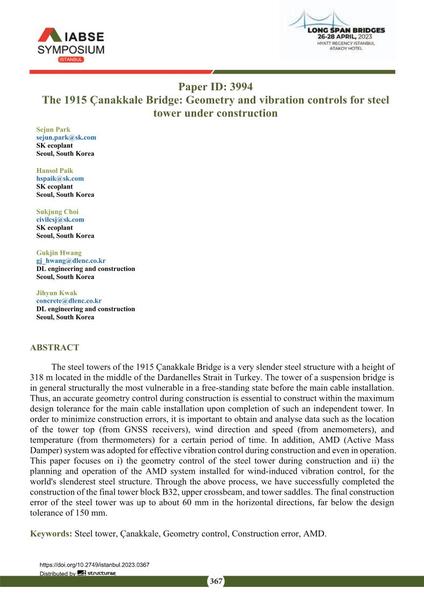The 1915 Çanakkale Bridge: Geometry and vibration controls for steel tower under construction

|
|
|||||||||||
Détails bibliographiques
| Auteur(s): |
Sejun Park
(SK ecoplant, Seoul, South Korea)
Hansol Paik (SK ecoplant, Seoul, South Korea) Sukjung Choi (SK ecoplant, Seoul, South Korea) Gukjin Hwang (DL engineering and construction Seoul, South Korea) Jihyun Kwak (DL engineering and construction Seoul, South Korea) |
||||
|---|---|---|---|---|---|
| Médium: | papier de conférence | ||||
| Langue(s): | anglais | ||||
| Conférence: | IABSE Symposium: Long Span Bridges, Istanbul, Turkey, 26-28 April 2023 | ||||
| Publié dans: | IABSE Symposium Istanbul 2023 | ||||
|
|||||
| Page(s): | 367-375 | ||||
| Nombre total de pages (du PDF): | 9 | ||||
| Année: | 2023 | ||||
| DOI: | 10.2749/istanbul.2023.0367 | ||||
| Abstrait: |
The steel towers of the 1915 Çanakkale Bridge is a very slender steel structure with a height of 318 m located in the middle of the Dardanelles Strait in Turkey. The tower of a suspension bridge is in general structurally the most vulnerable in a free-standing state before the main cable installation. Thus, an accurate geometry control during construction is essential to construct within the maximum design tolerance for the main cable installation upon completion of such an independent tower. In order to minimize construction errors, it is important to obtain and analyse data such as the location of the tower top (from GNSS receivers), wind direction and speed (from anemometers), and temperature (from thermometers) for a certain period of time. In addition, AMD (Active Mass Damper) system was adopted for effective vibration control during construction and even in operation. This paper focuses on i) the geometry control of the steel tower during construction and ii) the planning and operation of the AMD system installed for wind-induced vibration control, for the world's slenderest steel structure. Through the above process, we have successfully completed the construction of the final tower block B32, upper crossbeam, and tower saddles. The final construction error of the steel tower was up to about 60 mm in the horizontal directions, far below the design tolerance of 150 mm. |
||||
